Strategic Marketing Management Report for British Airways
VerifiedAdded on 2022/09/02
|20
|5629
|31
Report
AI Summary
This report provides a detailed analysis of the marketing management strategies employed by British Airways, a major airline company based in the United Kingdom. It begins by emphasizing the importance of a strategic marketing approach and examines the internal and external environments using SWOT and PESTLE analyses, respectively. The report delves into the key factors within the macro environment, including political, economic, social, technological, legal, and environmental influences, and how they impact British Airways' operations. It also explores market and competitor dynamics, as well as the application of segmentation, targeting, and positioning strategies. Furthermore, the report discusses branding, value propositions, and the role of a modern marketing manager. Finally, it offers recommendations and a conclusion, summarizing the key findings and strategic implications for British Airways in a competitive business landscape. The report aims to provide a comprehensive overview of marketing management principles and their practical application within the airline industry.
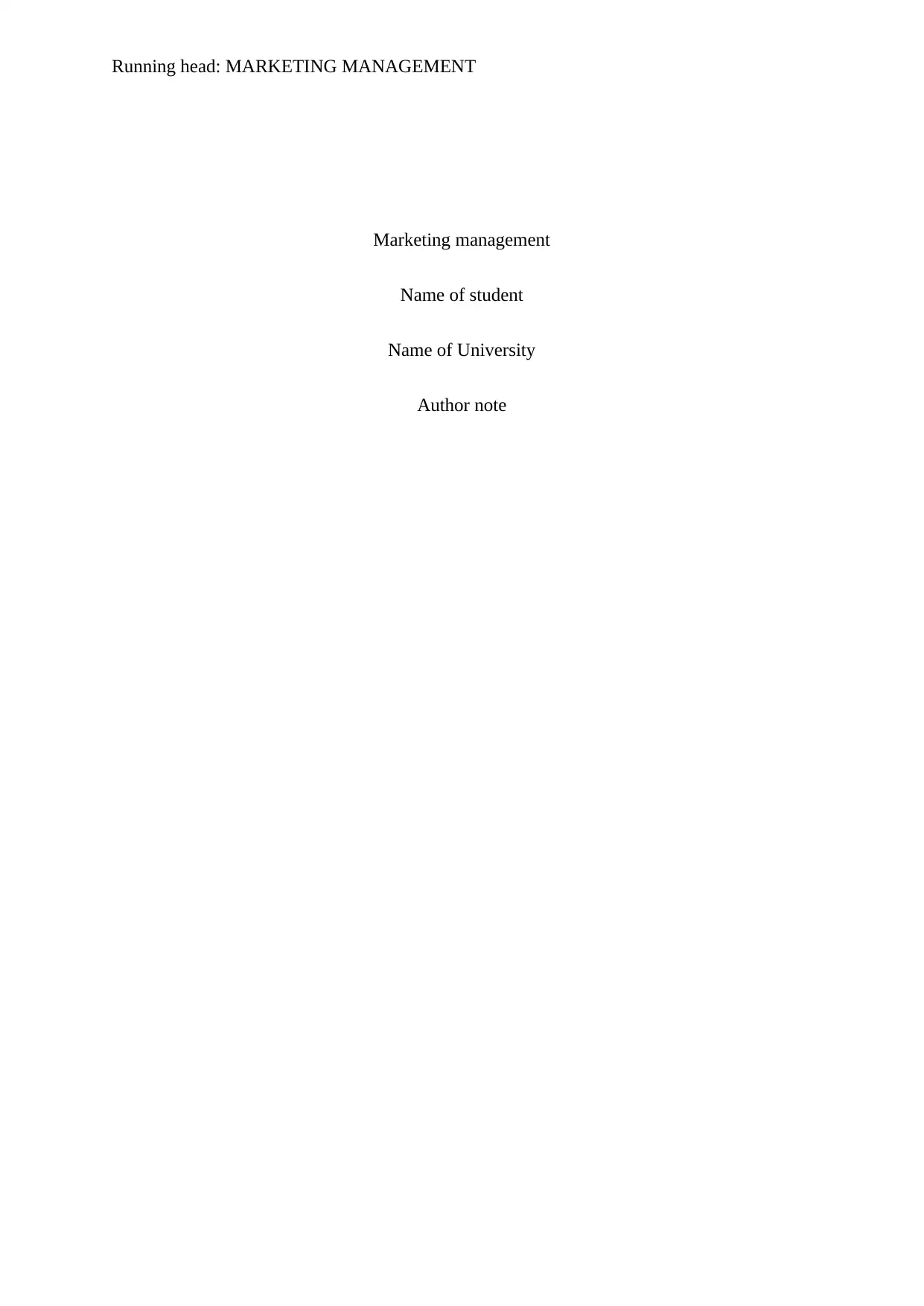
Running head: MARKETING MANAGEMENT
Marketing management
Name of student
Name of University
Author note
Marketing management
Name of student
Name of University
Author note
Paraphrase This Document
Need a fresh take? Get an instant paraphrase of this document with our AI Paraphraser

1
MARKETING MANAGEMENT
Table of Contents
Introduction................................................................................................................................3
Importance of environmental scanning within the marketing environment..............................3
Key factors within the macro environment................................................................................6
Market and competitors..............................................................................................................9
Segmentation, targeting and positioning....................................................................................9
Branding...................................................................................................................................11
Value proposition.....................................................................................................................12
Role of modern marketing manager.........................................................................................14
Recommendations....................................................................................................................15
Conclusion................................................................................................................................15
References................................................................................................................................16
MARKETING MANAGEMENT
Table of Contents
Introduction................................................................................................................................3
Importance of environmental scanning within the marketing environment..............................3
Key factors within the macro environment................................................................................6
Market and competitors..............................................................................................................9
Segmentation, targeting and positioning....................................................................................9
Branding...................................................................................................................................11
Value proposition.....................................................................................................................12
Role of modern marketing manager.........................................................................................14
Recommendations....................................................................................................................15
Conclusion................................................................................................................................15
References................................................................................................................................16
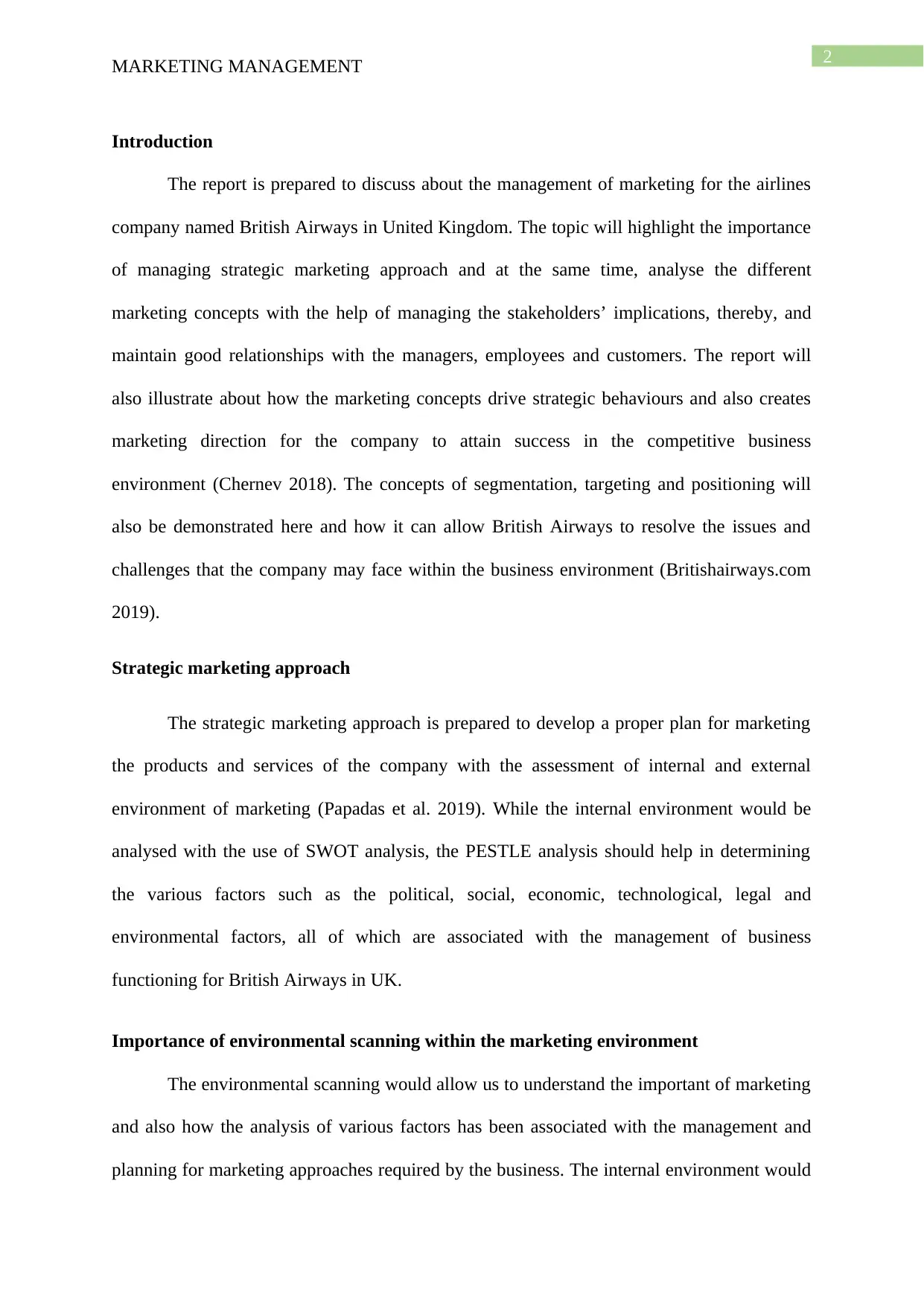
2
MARKETING MANAGEMENT
Introduction
The report is prepared to discuss about the management of marketing for the airlines
company named British Airways in United Kingdom. The topic will highlight the importance
of managing strategic marketing approach and at the same time, analyse the different
marketing concepts with the help of managing the stakeholders’ implications, thereby, and
maintain good relationships with the managers, employees and customers. The report will
also illustrate about how the marketing concepts drive strategic behaviours and also creates
marketing direction for the company to attain success in the competitive business
environment (Chernev 2018). The concepts of segmentation, targeting and positioning will
also be demonstrated here and how it can allow British Airways to resolve the issues and
challenges that the company may face within the business environment (Britishairways.com
2019).
Strategic marketing approach
The strategic marketing approach is prepared to develop a proper plan for marketing
the products and services of the company with the assessment of internal and external
environment of marketing (Papadas et al. 2019). While the internal environment would be
analysed with the use of SWOT analysis, the PESTLE analysis should help in determining
the various factors such as the political, social, economic, technological, legal and
environmental factors, all of which are associated with the management of business
functioning for British Airways in UK.
Importance of environmental scanning within the marketing environment
The environmental scanning would allow us to understand the important of marketing
and also how the analysis of various factors has been associated with the management and
planning for marketing approaches required by the business. The internal environment would
MARKETING MANAGEMENT
Introduction
The report is prepared to discuss about the management of marketing for the airlines
company named British Airways in United Kingdom. The topic will highlight the importance
of managing strategic marketing approach and at the same time, analyse the different
marketing concepts with the help of managing the stakeholders’ implications, thereby, and
maintain good relationships with the managers, employees and customers. The report will
also illustrate about how the marketing concepts drive strategic behaviours and also creates
marketing direction for the company to attain success in the competitive business
environment (Chernev 2018). The concepts of segmentation, targeting and positioning will
also be demonstrated here and how it can allow British Airways to resolve the issues and
challenges that the company may face within the business environment (Britishairways.com
2019).
Strategic marketing approach
The strategic marketing approach is prepared to develop a proper plan for marketing
the products and services of the company with the assessment of internal and external
environment of marketing (Papadas et al. 2019). While the internal environment would be
analysed with the use of SWOT analysis, the PESTLE analysis should help in determining
the various factors such as the political, social, economic, technological, legal and
environmental factors, all of which are associated with the management of business
functioning for British Airways in UK.
Importance of environmental scanning within the marketing environment
The environmental scanning would allow us to understand the important of marketing
and also how the analysis of various factors has been associated with the management and
planning for marketing approaches required by the business. The internal environment would
⊘ This is a preview!⊘
Do you want full access?
Subscribe today to unlock all pages.

Trusted by 1+ million students worldwide
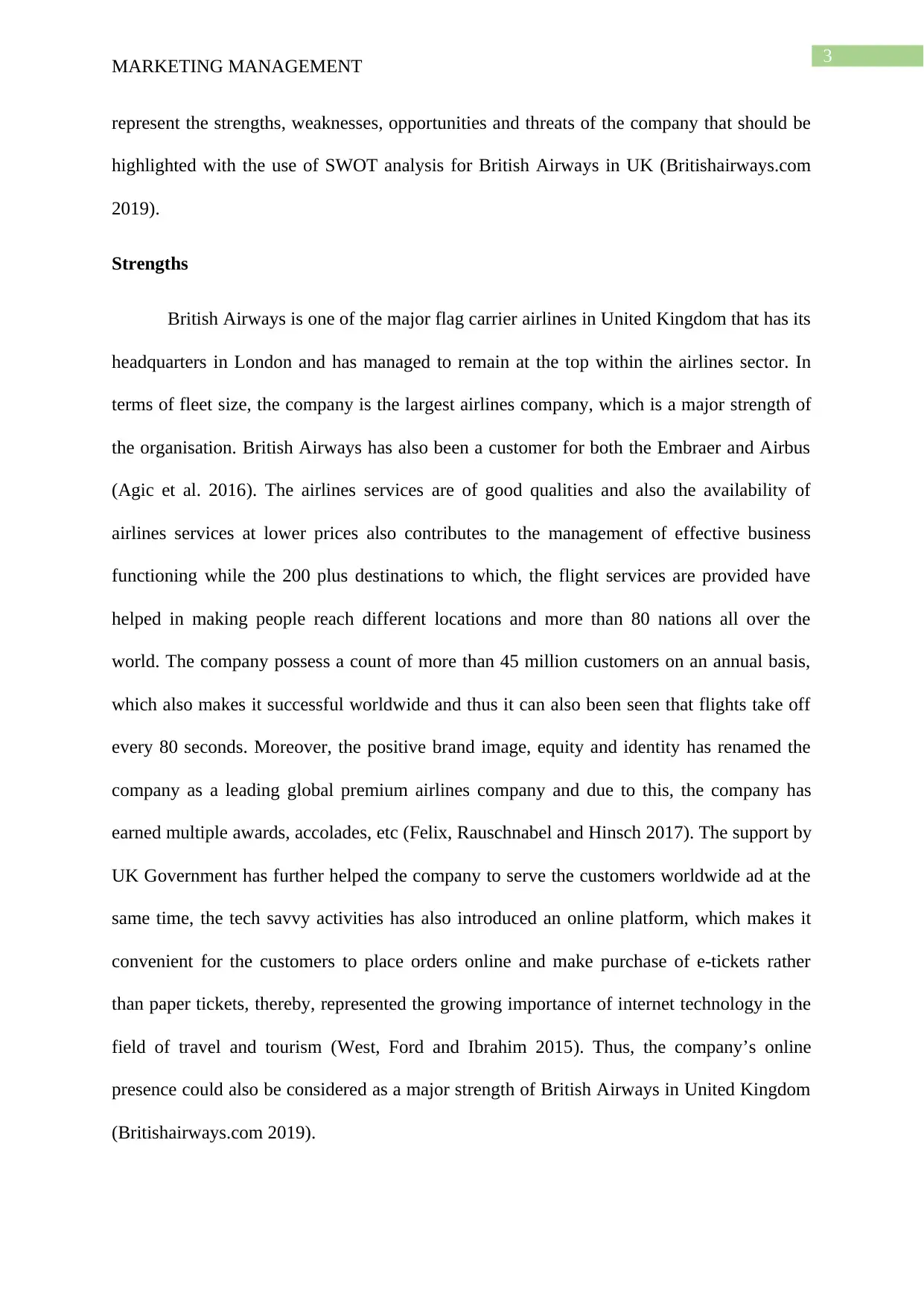
3
MARKETING MANAGEMENT
represent the strengths, weaknesses, opportunities and threats of the company that should be
highlighted with the use of SWOT analysis for British Airways in UK (Britishairways.com
2019).
Strengths
British Airways is one of the major flag carrier airlines in United Kingdom that has its
headquarters in London and has managed to remain at the top within the airlines sector. In
terms of fleet size, the company is the largest airlines company, which is a major strength of
the organisation. British Airways has also been a customer for both the Embraer and Airbus
(Agic et al. 2016). The airlines services are of good qualities and also the availability of
airlines services at lower prices also contributes to the management of effective business
functioning while the 200 plus destinations to which, the flight services are provided have
helped in making people reach different locations and more than 80 nations all over the
world. The company possess a count of more than 45 million customers on an annual basis,
which also makes it successful worldwide and thus it can also been seen that flights take off
every 80 seconds. Moreover, the positive brand image, equity and identity has renamed the
company as a leading global premium airlines company and due to this, the company has
earned multiple awards, accolades, etc (Felix, Rauschnabel and Hinsch 2017). The support by
UK Government has further helped the company to serve the customers worldwide ad at the
same time, the tech savvy activities has also introduced an online platform, which makes it
convenient for the customers to place orders online and make purchase of e-tickets rather
than paper tickets, thereby, represented the growing importance of internet technology in the
field of travel and tourism (West, Ford and Ibrahim 2015). Thus, the company’s online
presence could also be considered as a major strength of British Airways in United Kingdom
(Britishairways.com 2019).
MARKETING MANAGEMENT
represent the strengths, weaknesses, opportunities and threats of the company that should be
highlighted with the use of SWOT analysis for British Airways in UK (Britishairways.com
2019).
Strengths
British Airways is one of the major flag carrier airlines in United Kingdom that has its
headquarters in London and has managed to remain at the top within the airlines sector. In
terms of fleet size, the company is the largest airlines company, which is a major strength of
the organisation. British Airways has also been a customer for both the Embraer and Airbus
(Agic et al. 2016). The airlines services are of good qualities and also the availability of
airlines services at lower prices also contributes to the management of effective business
functioning while the 200 plus destinations to which, the flight services are provided have
helped in making people reach different locations and more than 80 nations all over the
world. The company possess a count of more than 45 million customers on an annual basis,
which also makes it successful worldwide and thus it can also been seen that flights take off
every 80 seconds. Moreover, the positive brand image, equity and identity has renamed the
company as a leading global premium airlines company and due to this, the company has
earned multiple awards, accolades, etc (Felix, Rauschnabel and Hinsch 2017). The support by
UK Government has further helped the company to serve the customers worldwide ad at the
same time, the tech savvy activities has also introduced an online platform, which makes it
convenient for the customers to place orders online and make purchase of e-tickets rather
than paper tickets, thereby, represented the growing importance of internet technology in the
field of travel and tourism (West, Ford and Ibrahim 2015). Thus, the company’s online
presence could also be considered as a major strength of British Airways in United Kingdom
(Britishairways.com 2019).
Paraphrase This Document
Need a fresh take? Get an instant paraphrase of this document with our AI Paraphraser

4
MARKETING MANAGEMENT
Weaknesses- In spite of the strengths, there are few major weaknesses as well for British
Airways in UK. These include excessive reliance or dependence on the UK markets as most
of the revenue is generated from the UK market, but this could be risky for the company to
function within the globalised economy sometimes. The large unionised workforce of British
Airways could also result in breaking down the process of bargaining and negotiations, which
should disrupt the business functions and processes and hereby, affect the overall
organisational performance (David, David and David 2017). This has also been followed by
extensive risks associated with the increased costs of employment and lack of penetration
into the globalised market. In spite of the worldwide presence of British Airways outside UK,
in few developing markets such as in India and China, the company has not been able to
make much mark, because of these highly potential markets consisting of increased
disposable income, economic conditions and changing lifestyle behaviours (Camilleri 2018).
Opportunities- Based on the weaknesses, there have been creation of few major scopes and
opportunities such as the expansion into different new markets because of the developing
economies and increased demands and expectations for interconnections between nations for
better management of trade relations. The high amounts of investments in travel related
infrastructure and the rising activities related to the travel and tourism activities have further
enhanced the opportunities for British Airways to reach out to the global markets and manage
international business (Meredith 2016). This could not only allow for creating more
convenience for the customers who want to travel by purchasing the airlines services of
British Airways, but would also help in generating higher revenue in business along with
enhancement of ability to attain competitive advantage in business. The implementation of
cost leadership strategy could also help the company to set competitive prices and raise the
chances of influencing customers’ buying behaviours largely (Kennedy 2016).
MARKETING MANAGEMENT
Weaknesses- In spite of the strengths, there are few major weaknesses as well for British
Airways in UK. These include excessive reliance or dependence on the UK markets as most
of the revenue is generated from the UK market, but this could be risky for the company to
function within the globalised economy sometimes. The large unionised workforce of British
Airways could also result in breaking down the process of bargaining and negotiations, which
should disrupt the business functions and processes and hereby, affect the overall
organisational performance (David, David and David 2017). This has also been followed by
extensive risks associated with the increased costs of employment and lack of penetration
into the globalised market. In spite of the worldwide presence of British Airways outside UK,
in few developing markets such as in India and China, the company has not been able to
make much mark, because of these highly potential markets consisting of increased
disposable income, economic conditions and changing lifestyle behaviours (Camilleri 2018).
Opportunities- Based on the weaknesses, there have been creation of few major scopes and
opportunities such as the expansion into different new markets because of the developing
economies and increased demands and expectations for interconnections between nations for
better management of trade relations. The high amounts of investments in travel related
infrastructure and the rising activities related to the travel and tourism activities have further
enhanced the opportunities for British Airways to reach out to the global markets and manage
international business (Meredith 2016). This could not only allow for creating more
convenience for the customers who want to travel by purchasing the airlines services of
British Airways, but would also help in generating higher revenue in business along with
enhancement of ability to attain competitive advantage in business. The implementation of
cost leadership strategy could also help the company to set competitive prices and raise the
chances of influencing customers’ buying behaviours largely (Kennedy 2016).
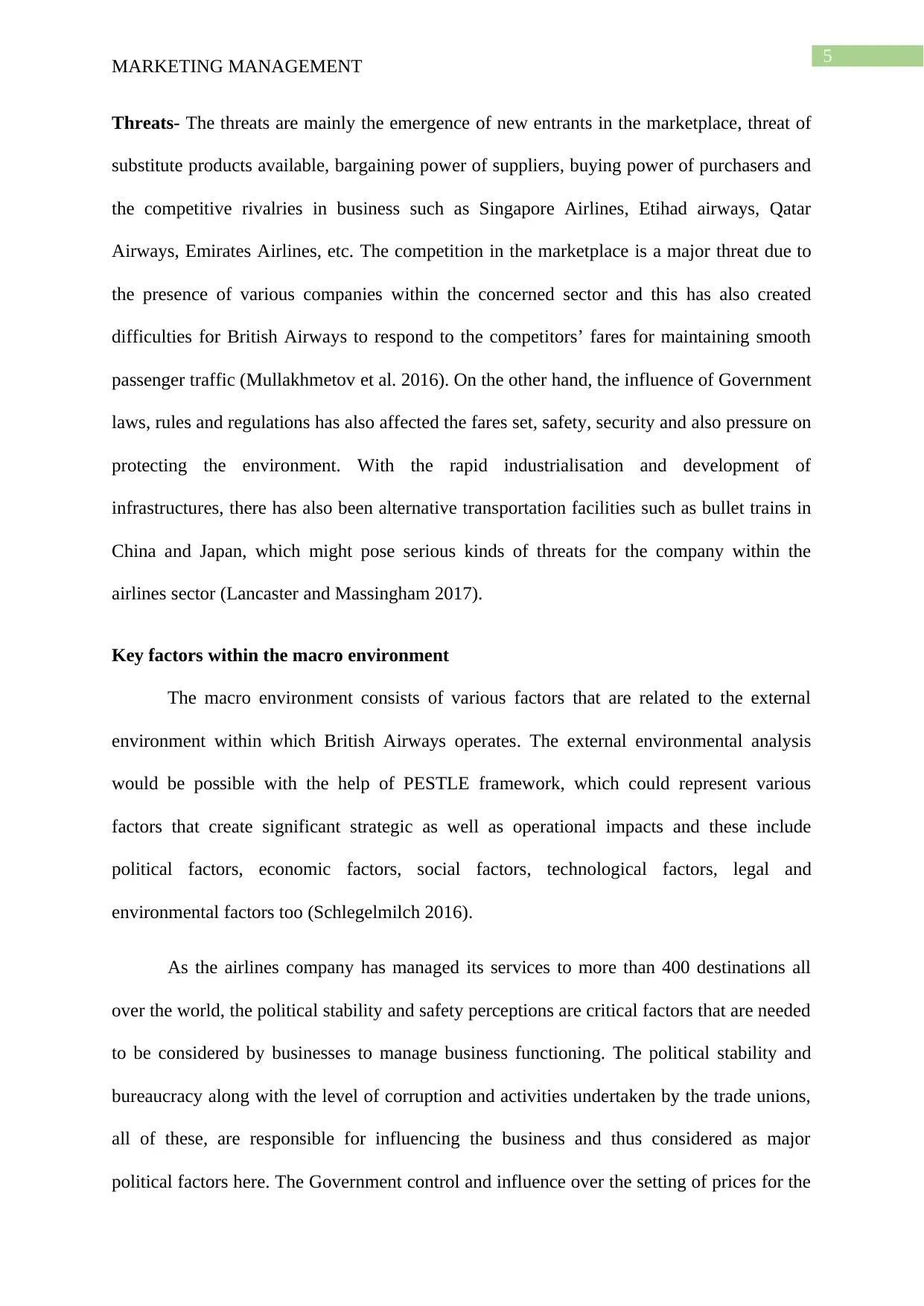
5
MARKETING MANAGEMENT
Threats- The threats are mainly the emergence of new entrants in the marketplace, threat of
substitute products available, bargaining power of suppliers, buying power of purchasers and
the competitive rivalries in business such as Singapore Airlines, Etihad airways, Qatar
Airways, Emirates Airlines, etc. The competition in the marketplace is a major threat due to
the presence of various companies within the concerned sector and this has also created
difficulties for British Airways to respond to the competitors’ fares for maintaining smooth
passenger traffic (Mullakhmetov et al. 2016). On the other hand, the influence of Government
laws, rules and regulations has also affected the fares set, safety, security and also pressure on
protecting the environment. With the rapid industrialisation and development of
infrastructures, there has also been alternative transportation facilities such as bullet trains in
China and Japan, which might pose serious kinds of threats for the company within the
airlines sector (Lancaster and Massingham 2017).
Key factors within the macro environment
The macro environment consists of various factors that are related to the external
environment within which British Airways operates. The external environmental analysis
would be possible with the help of PESTLE framework, which could represent various
factors that create significant strategic as well as operational impacts and these include
political factors, economic factors, social factors, technological factors, legal and
environmental factors too (Schlegelmilch 2016).
As the airlines company has managed its services to more than 400 destinations all
over the world, the political stability and safety perceptions are critical factors that are needed
to be considered by businesses to manage business functioning. The political stability and
bureaucracy along with the level of corruption and activities undertaken by the trade unions,
all of these, are responsible for influencing the business and thus considered as major
political factors here. The Government control and influence over the setting of prices for the
MARKETING MANAGEMENT
Threats- The threats are mainly the emergence of new entrants in the marketplace, threat of
substitute products available, bargaining power of suppliers, buying power of purchasers and
the competitive rivalries in business such as Singapore Airlines, Etihad airways, Qatar
Airways, Emirates Airlines, etc. The competition in the marketplace is a major threat due to
the presence of various companies within the concerned sector and this has also created
difficulties for British Airways to respond to the competitors’ fares for maintaining smooth
passenger traffic (Mullakhmetov et al. 2016). On the other hand, the influence of Government
laws, rules and regulations has also affected the fares set, safety, security and also pressure on
protecting the environment. With the rapid industrialisation and development of
infrastructures, there has also been alternative transportation facilities such as bullet trains in
China and Japan, which might pose serious kinds of threats for the company within the
airlines sector (Lancaster and Massingham 2017).
Key factors within the macro environment
The macro environment consists of various factors that are related to the external
environment within which British Airways operates. The external environmental analysis
would be possible with the help of PESTLE framework, which could represent various
factors that create significant strategic as well as operational impacts and these include
political factors, economic factors, social factors, technological factors, legal and
environmental factors too (Schlegelmilch 2016).
As the airlines company has managed its services to more than 400 destinations all
over the world, the political stability and safety perceptions are critical factors that are needed
to be considered by businesses to manage business functioning. The political stability and
bureaucracy along with the level of corruption and activities undertaken by the trade unions,
all of these, are responsible for influencing the business and thus considered as major
political factors here. The Government control and influence over the setting of prices for the
⊘ This is a preview!⊘
Do you want full access?
Subscribe today to unlock all pages.

Trusted by 1+ million students worldwide
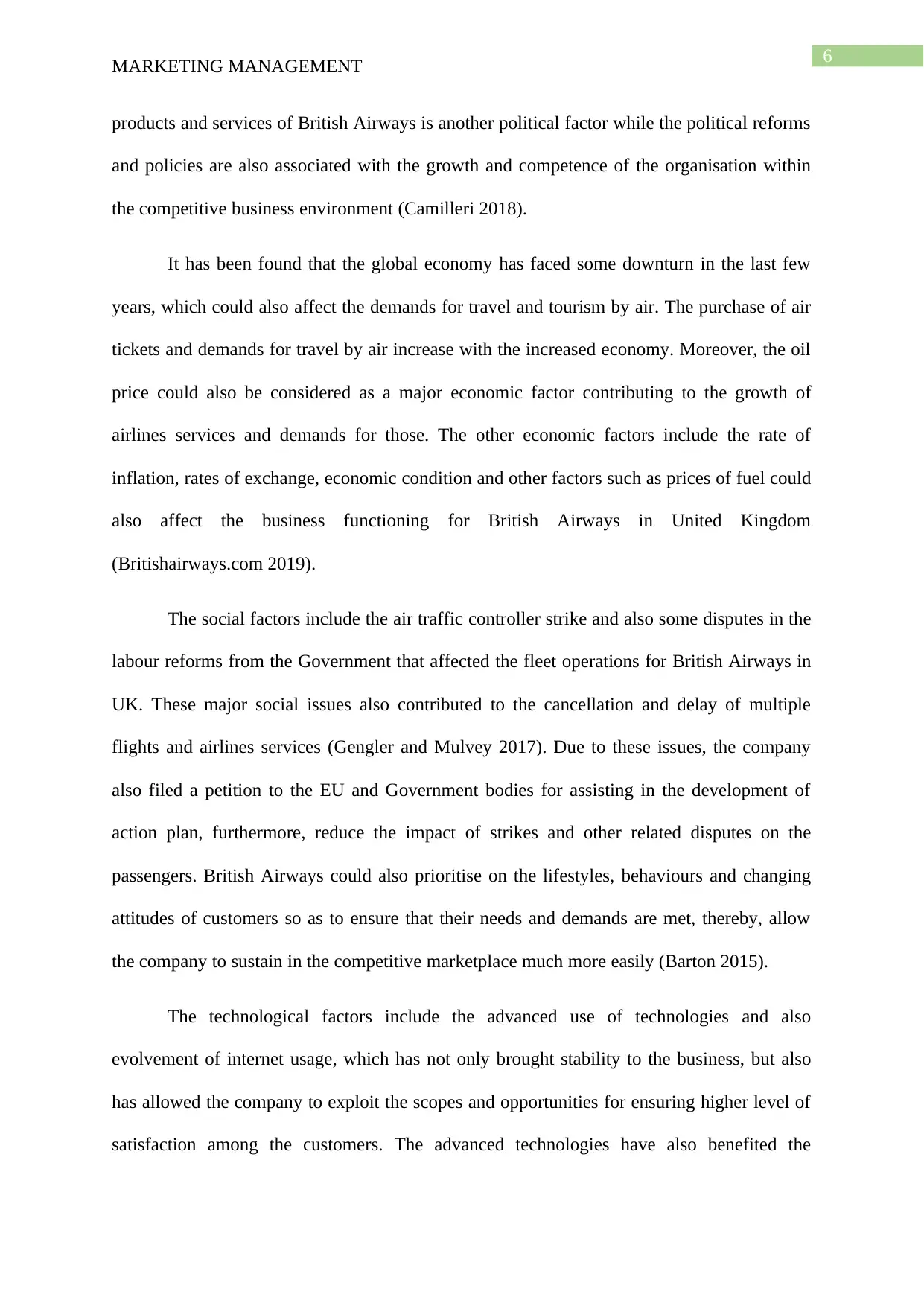
6
MARKETING MANAGEMENT
products and services of British Airways is another political factor while the political reforms
and policies are also associated with the growth and competence of the organisation within
the competitive business environment (Camilleri 2018).
It has been found that the global economy has faced some downturn in the last few
years, which could also affect the demands for travel and tourism by air. The purchase of air
tickets and demands for travel by air increase with the increased economy. Moreover, the oil
price could also be considered as a major economic factor contributing to the growth of
airlines services and demands for those. The other economic factors include the rate of
inflation, rates of exchange, economic condition and other factors such as prices of fuel could
also affect the business functioning for British Airways in United Kingdom
(Britishairways.com 2019).
The social factors include the air traffic controller strike and also some disputes in the
labour reforms from the Government that affected the fleet operations for British Airways in
UK. These major social issues also contributed to the cancellation and delay of multiple
flights and airlines services (Gengler and Mulvey 2017). Due to these issues, the company
also filed a petition to the EU and Government bodies for assisting in the development of
action plan, furthermore, reduce the impact of strikes and other related disputes on the
passengers. British Airways could also prioritise on the lifestyles, behaviours and changing
attitudes of customers so as to ensure that their needs and demands are met, thereby, allow
the company to sustain in the competitive marketplace much more easily (Barton 2015).
The technological factors include the advanced use of technologies and also
evolvement of internet usage, which has not only brought stability to the business, but also
has allowed the company to exploit the scopes and opportunities for ensuring higher level of
satisfaction among the customers. The advanced technologies have also benefited the
MARKETING MANAGEMENT
products and services of British Airways is another political factor while the political reforms
and policies are also associated with the growth and competence of the organisation within
the competitive business environment (Camilleri 2018).
It has been found that the global economy has faced some downturn in the last few
years, which could also affect the demands for travel and tourism by air. The purchase of air
tickets and demands for travel by air increase with the increased economy. Moreover, the oil
price could also be considered as a major economic factor contributing to the growth of
airlines services and demands for those. The other economic factors include the rate of
inflation, rates of exchange, economic condition and other factors such as prices of fuel could
also affect the business functioning for British Airways in United Kingdom
(Britishairways.com 2019).
The social factors include the air traffic controller strike and also some disputes in the
labour reforms from the Government that affected the fleet operations for British Airways in
UK. These major social issues also contributed to the cancellation and delay of multiple
flights and airlines services (Gengler and Mulvey 2017). Due to these issues, the company
also filed a petition to the EU and Government bodies for assisting in the development of
action plan, furthermore, reduce the impact of strikes and other related disputes on the
passengers. British Airways could also prioritise on the lifestyles, behaviours and changing
attitudes of customers so as to ensure that their needs and demands are met, thereby, allow
the company to sustain in the competitive marketplace much more easily (Barton 2015).
The technological factors include the advanced use of technologies and also
evolvement of internet usage, which has not only brought stability to the business, but also
has allowed the company to exploit the scopes and opportunities for ensuring higher level of
satisfaction among the customers. The advanced technologies have also benefited the
Paraphrase This Document
Need a fresh take? Get an instant paraphrase of this document with our AI Paraphraser
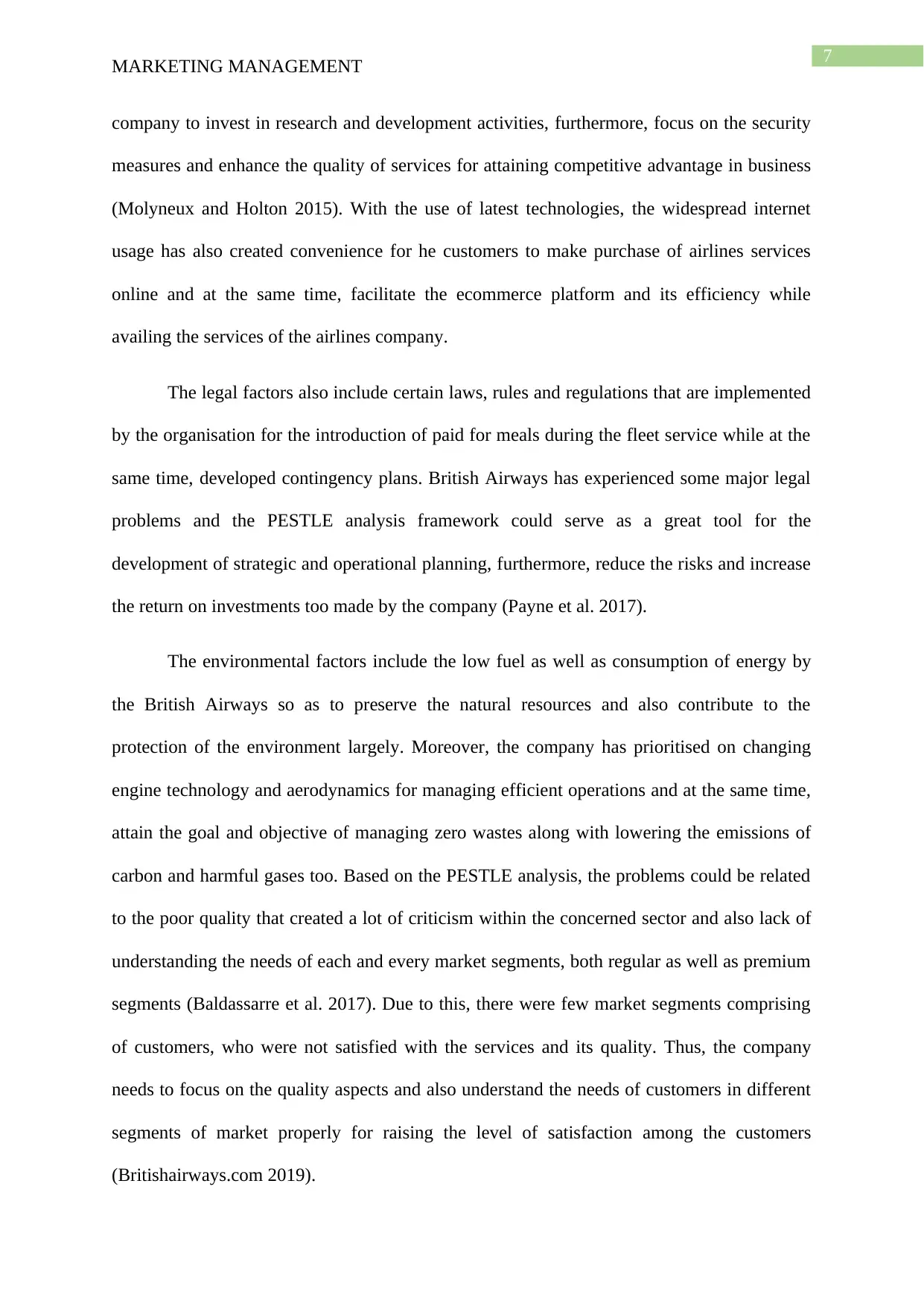
7
MARKETING MANAGEMENT
company to invest in research and development activities, furthermore, focus on the security
measures and enhance the quality of services for attaining competitive advantage in business
(Molyneux and Holton 2015). With the use of latest technologies, the widespread internet
usage has also created convenience for he customers to make purchase of airlines services
online and at the same time, facilitate the ecommerce platform and its efficiency while
availing the services of the airlines company.
The legal factors also include certain laws, rules and regulations that are implemented
by the organisation for the introduction of paid for meals during the fleet service while at the
same time, developed contingency plans. British Airways has experienced some major legal
problems and the PESTLE analysis framework could serve as a great tool for the
development of strategic and operational planning, furthermore, reduce the risks and increase
the return on investments too made by the company (Payne et al. 2017).
The environmental factors include the low fuel as well as consumption of energy by
the British Airways so as to preserve the natural resources and also contribute to the
protection of the environment largely. Moreover, the company has prioritised on changing
engine technology and aerodynamics for managing efficient operations and at the same time,
attain the goal and objective of managing zero wastes along with lowering the emissions of
carbon and harmful gases too. Based on the PESTLE analysis, the problems could be related
to the poor quality that created a lot of criticism within the concerned sector and also lack of
understanding the needs of each and every market segments, both regular as well as premium
segments (Baldassarre et al. 2017). Due to this, there were few market segments comprising
of customers, who were not satisfied with the services and its quality. Thus, the company
needs to focus on the quality aspects and also understand the needs of customers in different
segments of market properly for raising the level of satisfaction among the customers
(Britishairways.com 2019).
MARKETING MANAGEMENT
company to invest in research and development activities, furthermore, focus on the security
measures and enhance the quality of services for attaining competitive advantage in business
(Molyneux and Holton 2015). With the use of latest technologies, the widespread internet
usage has also created convenience for he customers to make purchase of airlines services
online and at the same time, facilitate the ecommerce platform and its efficiency while
availing the services of the airlines company.
The legal factors also include certain laws, rules and regulations that are implemented
by the organisation for the introduction of paid for meals during the fleet service while at the
same time, developed contingency plans. British Airways has experienced some major legal
problems and the PESTLE analysis framework could serve as a great tool for the
development of strategic and operational planning, furthermore, reduce the risks and increase
the return on investments too made by the company (Payne et al. 2017).
The environmental factors include the low fuel as well as consumption of energy by
the British Airways so as to preserve the natural resources and also contribute to the
protection of the environment largely. Moreover, the company has prioritised on changing
engine technology and aerodynamics for managing efficient operations and at the same time,
attain the goal and objective of managing zero wastes along with lowering the emissions of
carbon and harmful gases too. Based on the PESTLE analysis, the problems could be related
to the poor quality that created a lot of criticism within the concerned sector and also lack of
understanding the needs of each and every market segments, both regular as well as premium
segments (Baldassarre et al. 2017). Due to this, there were few market segments comprising
of customers, who were not satisfied with the services and its quality. Thus, the company
needs to focus on the quality aspects and also understand the needs of customers in different
segments of market properly for raising the level of satisfaction among the customers
(Britishairways.com 2019).
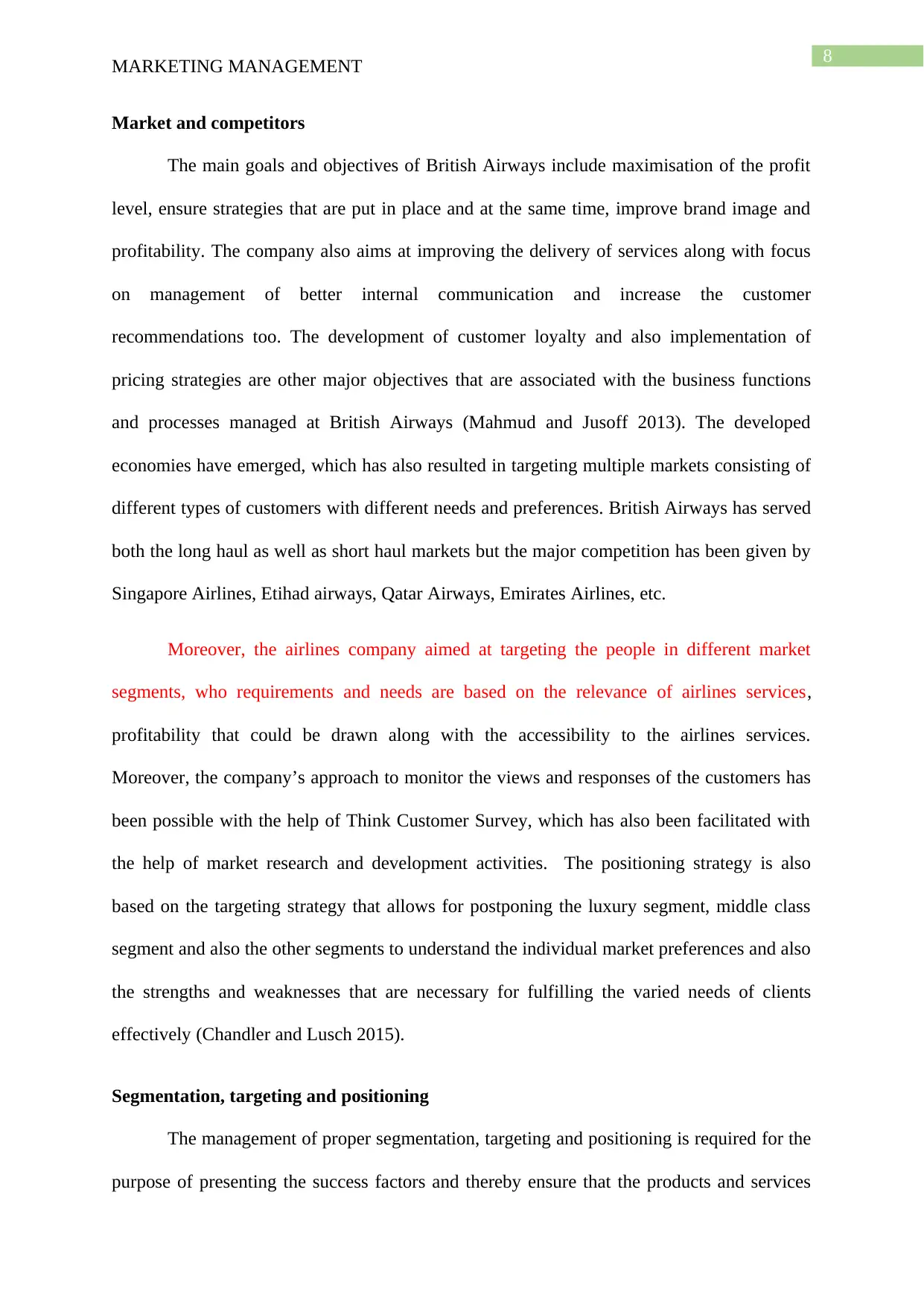
8
MARKETING MANAGEMENT
Market and competitors
The main goals and objectives of British Airways include maximisation of the profit
level, ensure strategies that are put in place and at the same time, improve brand image and
profitability. The company also aims at improving the delivery of services along with focus
on management of better internal communication and increase the customer
recommendations too. The development of customer loyalty and also implementation of
pricing strategies are other major objectives that are associated with the business functions
and processes managed at British Airways (Mahmud and Jusoff 2013). The developed
economies have emerged, which has also resulted in targeting multiple markets consisting of
different types of customers with different needs and preferences. British Airways has served
both the long haul as well as short haul markets but the major competition has been given by
Singapore Airlines, Etihad airways, Qatar Airways, Emirates Airlines, etc.
Moreover, the airlines company aimed at targeting the people in different market
segments, who requirements and needs are based on the relevance of airlines services,
profitability that could be drawn along with the accessibility to the airlines services.
Moreover, the company’s approach to monitor the views and responses of the customers has
been possible with the help of Think Customer Survey, which has also been facilitated with
the help of market research and development activities. The positioning strategy is also
based on the targeting strategy that allows for postponing the luxury segment, middle class
segment and also the other segments to understand the individual market preferences and also
the strengths and weaknesses that are necessary for fulfilling the varied needs of clients
effectively (Chandler and Lusch 2015).
Segmentation, targeting and positioning
The management of proper segmentation, targeting and positioning is required for the
purpose of presenting the success factors and thereby ensure that the products and services
MARKETING MANAGEMENT
Market and competitors
The main goals and objectives of British Airways include maximisation of the profit
level, ensure strategies that are put in place and at the same time, improve brand image and
profitability. The company also aims at improving the delivery of services along with focus
on management of better internal communication and increase the customer
recommendations too. The development of customer loyalty and also implementation of
pricing strategies are other major objectives that are associated with the business functions
and processes managed at British Airways (Mahmud and Jusoff 2013). The developed
economies have emerged, which has also resulted in targeting multiple markets consisting of
different types of customers with different needs and preferences. British Airways has served
both the long haul as well as short haul markets but the major competition has been given by
Singapore Airlines, Etihad airways, Qatar Airways, Emirates Airlines, etc.
Moreover, the airlines company aimed at targeting the people in different market
segments, who requirements and needs are based on the relevance of airlines services,
profitability that could be drawn along with the accessibility to the airlines services.
Moreover, the company’s approach to monitor the views and responses of the customers has
been possible with the help of Think Customer Survey, which has also been facilitated with
the help of market research and development activities. The positioning strategy is also
based on the targeting strategy that allows for postponing the luxury segment, middle class
segment and also the other segments to understand the individual market preferences and also
the strengths and weaknesses that are necessary for fulfilling the varied needs of clients
effectively (Chandler and Lusch 2015).
Segmentation, targeting and positioning
The management of proper segmentation, targeting and positioning is required for the
purpose of presenting the success factors and thereby ensure that the products and services
⊘ This is a preview!⊘
Do you want full access?
Subscribe today to unlock all pages.

Trusted by 1+ million students worldwide
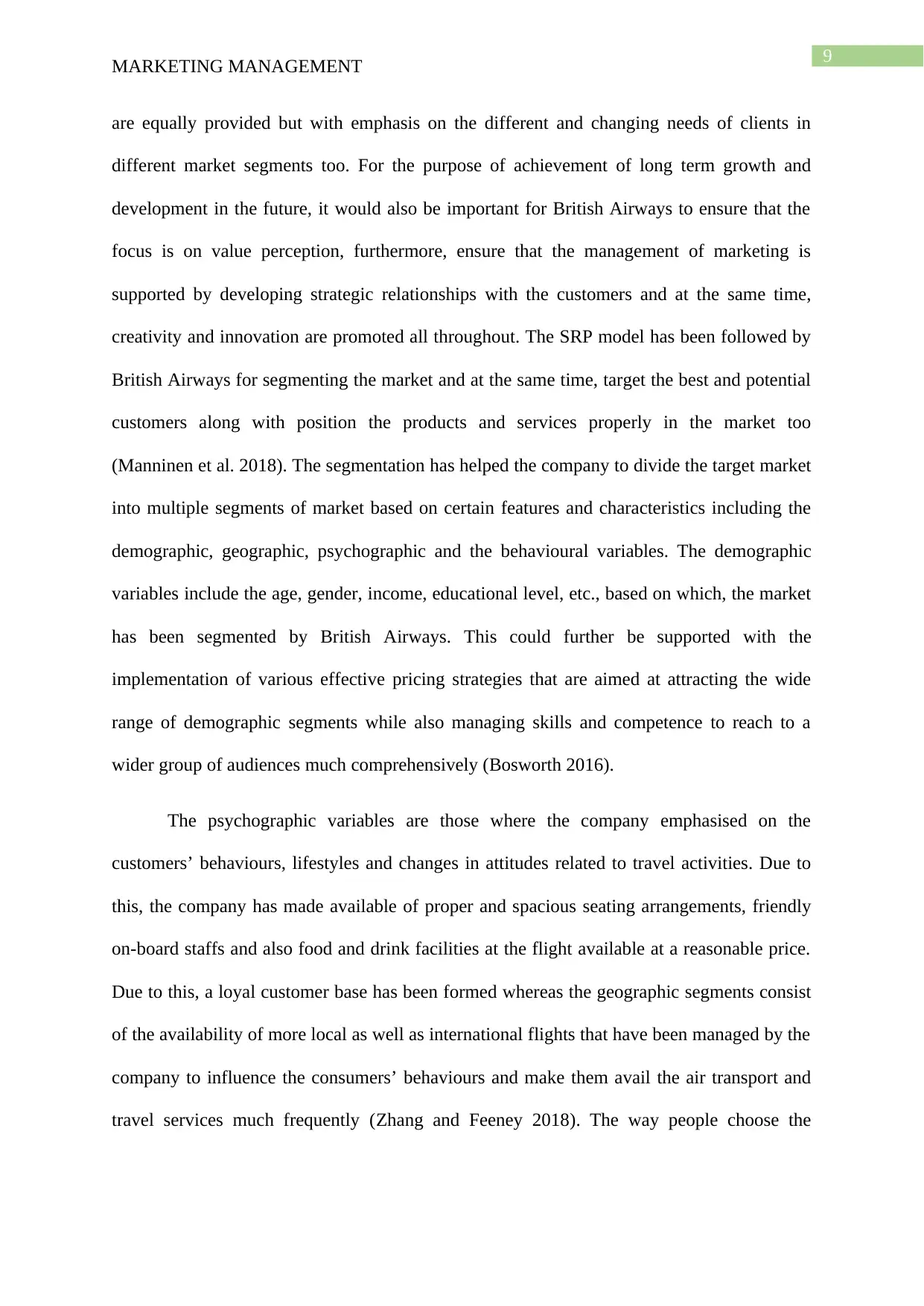
9
MARKETING MANAGEMENT
are equally provided but with emphasis on the different and changing needs of clients in
different market segments too. For the purpose of achievement of long term growth and
development in the future, it would also be important for British Airways to ensure that the
focus is on value perception, furthermore, ensure that the management of marketing is
supported by developing strategic relationships with the customers and at the same time,
creativity and innovation are promoted all throughout. The SRP model has been followed by
British Airways for segmenting the market and at the same time, target the best and potential
customers along with position the products and services properly in the market too
(Manninen et al. 2018). The segmentation has helped the company to divide the target market
into multiple segments of market based on certain features and characteristics including the
demographic, geographic, psychographic and the behavioural variables. The demographic
variables include the age, gender, income, educational level, etc., based on which, the market
has been segmented by British Airways. This could further be supported with the
implementation of various effective pricing strategies that are aimed at attracting the wide
range of demographic segments while also managing skills and competence to reach to a
wider group of audiences much comprehensively (Bosworth 2016).
The psychographic variables are those where the company emphasised on the
customers’ behaviours, lifestyles and changes in attitudes related to travel activities. Due to
this, the company has made available of proper and spacious seating arrangements, friendly
on-board staffs and also food and drink facilities at the flight available at a reasonable price.
Due to this, a loyal customer base has been formed whereas the geographic segments consist
of the availability of more local as well as international flights that have been managed by the
company to influence the consumers’ behaviours and make them avail the air transport and
travel services much frequently (Zhang and Feeney 2018). The way people choose the
MARKETING MANAGEMENT
are equally provided but with emphasis on the different and changing needs of clients in
different market segments too. For the purpose of achievement of long term growth and
development in the future, it would also be important for British Airways to ensure that the
focus is on value perception, furthermore, ensure that the management of marketing is
supported by developing strategic relationships with the customers and at the same time,
creativity and innovation are promoted all throughout. The SRP model has been followed by
British Airways for segmenting the market and at the same time, target the best and potential
customers along with position the products and services properly in the market too
(Manninen et al. 2018). The segmentation has helped the company to divide the target market
into multiple segments of market based on certain features and characteristics including the
demographic, geographic, psychographic and the behavioural variables. The demographic
variables include the age, gender, income, educational level, etc., based on which, the market
has been segmented by British Airways. This could further be supported with the
implementation of various effective pricing strategies that are aimed at attracting the wide
range of demographic segments while also managing skills and competence to reach to a
wider group of audiences much comprehensively (Bosworth 2016).
The psychographic variables are those where the company emphasised on the
customers’ behaviours, lifestyles and changes in attitudes related to travel activities. Due to
this, the company has made available of proper and spacious seating arrangements, friendly
on-board staffs and also food and drink facilities at the flight available at a reasonable price.
Due to this, a loyal customer base has been formed whereas the geographic segments consist
of the availability of more local as well as international flights that have been managed by the
company to influence the consumers’ behaviours and make them avail the air transport and
travel services much frequently (Zhang and Feeney 2018). The way people choose the
Paraphrase This Document
Need a fresh take? Get an instant paraphrase of this document with our AI Paraphraser
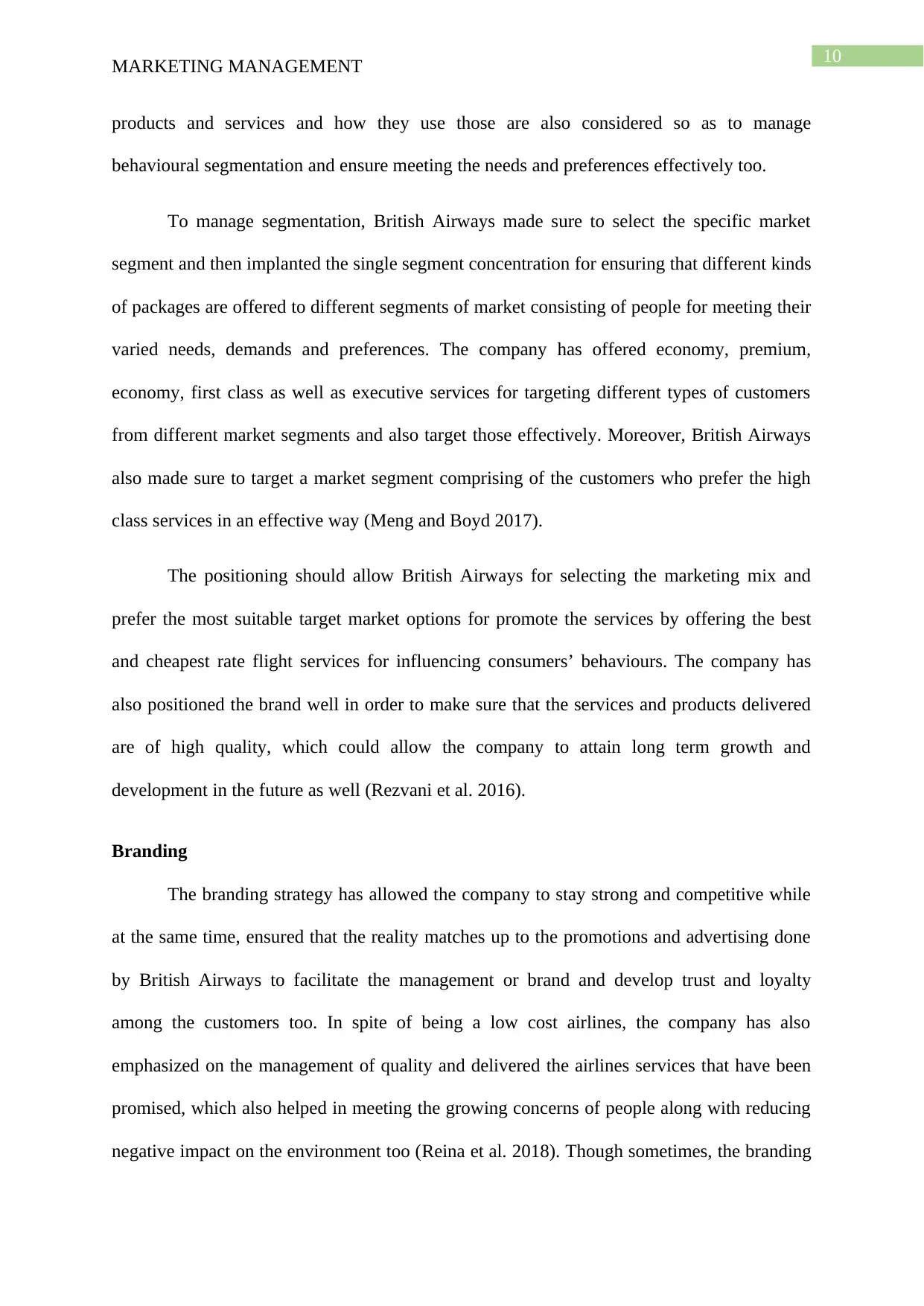
10
MARKETING MANAGEMENT
products and services and how they use those are also considered so as to manage
behavioural segmentation and ensure meeting the needs and preferences effectively too.
To manage segmentation, British Airways made sure to select the specific market
segment and then implanted the single segment concentration for ensuring that different kinds
of packages are offered to different segments of market consisting of people for meeting their
varied needs, demands and preferences. The company has offered economy, premium,
economy, first class as well as executive services for targeting different types of customers
from different market segments and also target those effectively. Moreover, British Airways
also made sure to target a market segment comprising of the customers who prefer the high
class services in an effective way (Meng and Boyd 2017).
The positioning should allow British Airways for selecting the marketing mix and
prefer the most suitable target market options for promote the services by offering the best
and cheapest rate flight services for influencing consumers’ behaviours. The company has
also positioned the brand well in order to make sure that the services and products delivered
are of high quality, which could allow the company to attain long term growth and
development in the future as well (Rezvani et al. 2016).
Branding
The branding strategy has allowed the company to stay strong and competitive while
at the same time, ensured that the reality matches up to the promotions and advertising done
by British Airways to facilitate the management or brand and develop trust and loyalty
among the customers too. In spite of being a low cost airlines, the company has also
emphasized on the management of quality and delivered the airlines services that have been
promised, which also helped in meeting the growing concerns of people along with reducing
negative impact on the environment too (Reina et al. 2018). Though sometimes, the branding
MARKETING MANAGEMENT
products and services and how they use those are also considered so as to manage
behavioural segmentation and ensure meeting the needs and preferences effectively too.
To manage segmentation, British Airways made sure to select the specific market
segment and then implanted the single segment concentration for ensuring that different kinds
of packages are offered to different segments of market consisting of people for meeting their
varied needs, demands and preferences. The company has offered economy, premium,
economy, first class as well as executive services for targeting different types of customers
from different market segments and also target those effectively. Moreover, British Airways
also made sure to target a market segment comprising of the customers who prefer the high
class services in an effective way (Meng and Boyd 2017).
The positioning should allow British Airways for selecting the marketing mix and
prefer the most suitable target market options for promote the services by offering the best
and cheapest rate flight services for influencing consumers’ behaviours. The company has
also positioned the brand well in order to make sure that the services and products delivered
are of high quality, which could allow the company to attain long term growth and
development in the future as well (Rezvani et al. 2016).
Branding
The branding strategy has allowed the company to stay strong and competitive while
at the same time, ensured that the reality matches up to the promotions and advertising done
by British Airways to facilitate the management or brand and develop trust and loyalty
among the customers too. In spite of being a low cost airlines, the company has also
emphasized on the management of quality and delivered the airlines services that have been
promised, which also helped in meeting the growing concerns of people along with reducing
negative impact on the environment too (Reina et al. 2018). Though sometimes, the branding
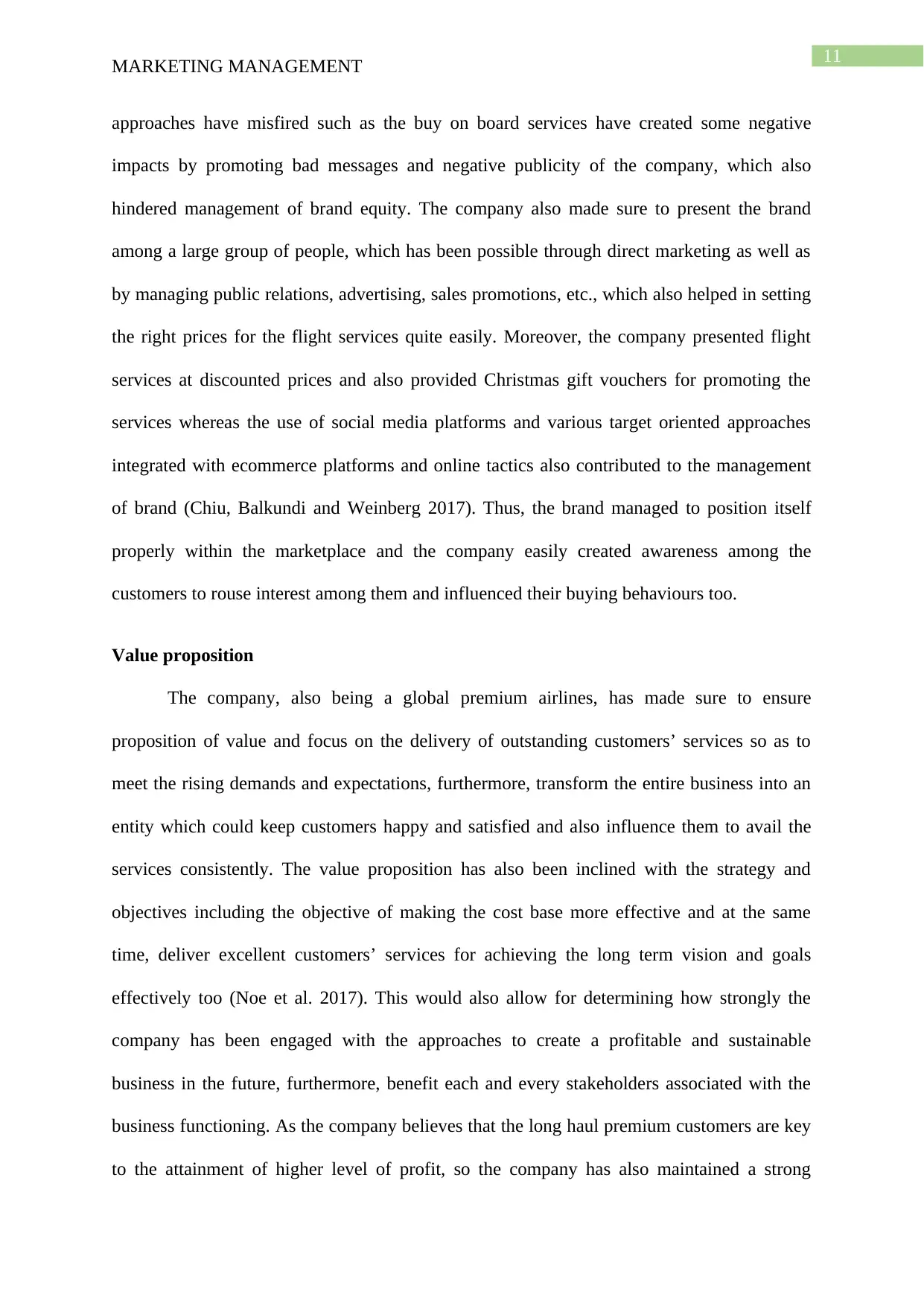
11
MARKETING MANAGEMENT
approaches have misfired such as the buy on board services have created some negative
impacts by promoting bad messages and negative publicity of the company, which also
hindered management of brand equity. The company also made sure to present the brand
among a large group of people, which has been possible through direct marketing as well as
by managing public relations, advertising, sales promotions, etc., which also helped in setting
the right prices for the flight services quite easily. Moreover, the company presented flight
services at discounted prices and also provided Christmas gift vouchers for promoting the
services whereas the use of social media platforms and various target oriented approaches
integrated with ecommerce platforms and online tactics also contributed to the management
of brand (Chiu, Balkundi and Weinberg 2017). Thus, the brand managed to position itself
properly within the marketplace and the company easily created awareness among the
customers to rouse interest among them and influenced their buying behaviours too.
Value proposition
The company, also being a global premium airlines, has made sure to ensure
proposition of value and focus on the delivery of outstanding customers’ services so as to
meet the rising demands and expectations, furthermore, transform the entire business into an
entity which could keep customers happy and satisfied and also influence them to avail the
services consistently. The value proposition has also been inclined with the strategy and
objectives including the objective of making the cost base more effective and at the same
time, deliver excellent customers’ services for achieving the long term vision and goals
effectively too (Noe et al. 2017). This would also allow for determining how strongly the
company has been engaged with the approaches to create a profitable and sustainable
business in the future, furthermore, benefit each and every stakeholders associated with the
business functioning. As the company believes that the long haul premium customers are key
to the attainment of higher level of profit, so the company has also maintained a strong
MARKETING MANAGEMENT
approaches have misfired such as the buy on board services have created some negative
impacts by promoting bad messages and negative publicity of the company, which also
hindered management of brand equity. The company also made sure to present the brand
among a large group of people, which has been possible through direct marketing as well as
by managing public relations, advertising, sales promotions, etc., which also helped in setting
the right prices for the flight services quite easily. Moreover, the company presented flight
services at discounted prices and also provided Christmas gift vouchers for promoting the
services whereas the use of social media platforms and various target oriented approaches
integrated with ecommerce platforms and online tactics also contributed to the management
of brand (Chiu, Balkundi and Weinberg 2017). Thus, the brand managed to position itself
properly within the marketplace and the company easily created awareness among the
customers to rouse interest among them and influenced their buying behaviours too.
Value proposition
The company, also being a global premium airlines, has made sure to ensure
proposition of value and focus on the delivery of outstanding customers’ services so as to
meet the rising demands and expectations, furthermore, transform the entire business into an
entity which could keep customers happy and satisfied and also influence them to avail the
services consistently. The value proposition has also been inclined with the strategy and
objectives including the objective of making the cost base more effective and at the same
time, deliver excellent customers’ services for achieving the long term vision and goals
effectively too (Noe et al. 2017). This would also allow for determining how strongly the
company has been engaged with the approaches to create a profitable and sustainable
business in the future, furthermore, benefit each and every stakeholders associated with the
business functioning. As the company believes that the long haul premium customers are key
to the attainment of higher level of profit, so the company has also maintained a strong
⊘ This is a preview!⊘
Do you want full access?
Subscribe today to unlock all pages.

Trusted by 1+ million students worldwide
1 out of 20
Related Documents
Your All-in-One AI-Powered Toolkit for Academic Success.
+13062052269
info@desklib.com
Available 24*7 on WhatsApp / Email
![[object Object]](/_next/static/media/star-bottom.7253800d.svg)
Unlock your academic potential
Copyright © 2020–2025 A2Z Services. All Rights Reserved. Developed and managed by ZUCOL.




